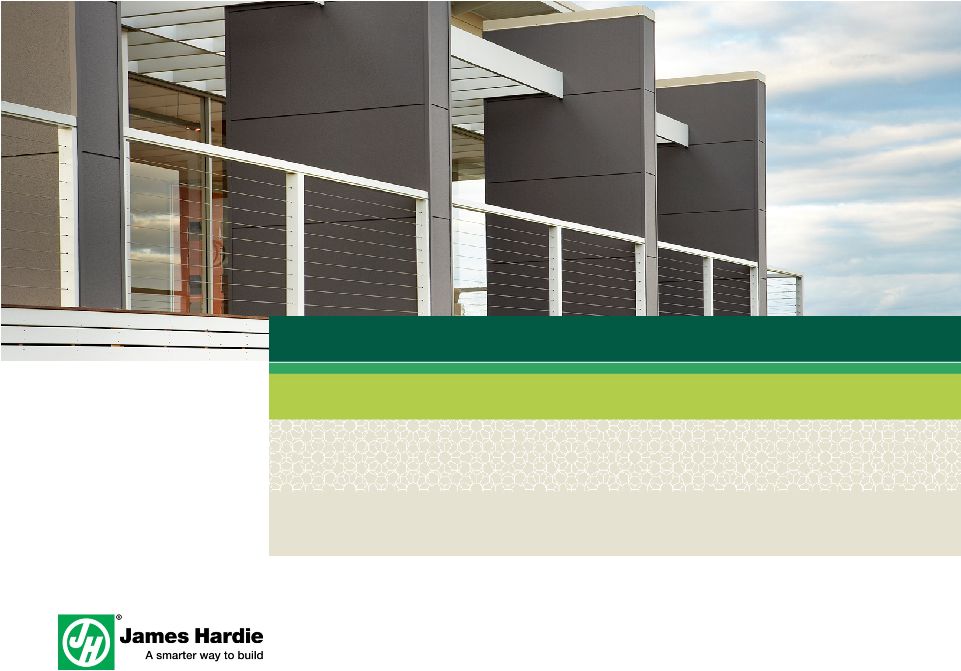    James
Hardie Australia Investor Presentation
July 2014
Exhibit 99.1 |
    James
Hardie Australia Investor Presentation
July 2014
Exhibit 99.1 |
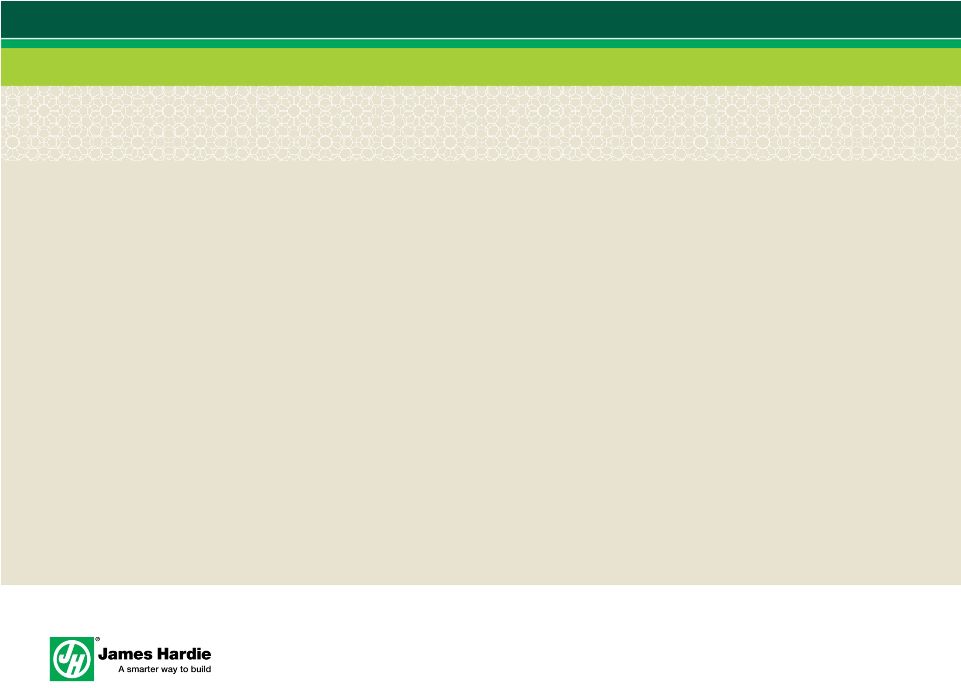 Disclaimer:
This management presentation contains forward-looking statements. James Hardie
may from time to time make forward-looking statements in its periodic reports filed
with
or
furnished
to
the
SEC,
on
Forms
20-F
and
6-K,
in
its
annual
reports
to
shareholders,
in
offering
circulars,
invitation
memoranda
and
prospectuses,
in
media
releases
and
other
written
materials
and
in
oral
statements
made
by
the
company’s
officers,
directors
or
employees
to
analysts,
institutional
investors,
existing
and
potential lenders, representatives of the media and others. Statements that are not
historical facts are forward-looking statements and such forward-looking statements
are statements made pursuant to the Safe Harbor Provisions of the Private
Securities Litigation Reform Act of 1995. Examples of forward-looking
statements include: •
statements
about
the
company’s
future
performance;
•
projections
of
the
company’s
results
of
operations
or
financial
condition;
•
statements
regarding
the
company’s
plans,
objectives
or
goals,
including
those
relating
to
strategies,
initiatives,
competition,
acquisitions,
dispositions
and/or
its
products;
•
expectations
concerning
the
costs
associated
with
the
suspension
or
closure
of
operations
at
any
of
the
company’s
plants
and
future
plans
with
respect
to
any
such plants;
•
expectations
concerning
the
costs
associated
with
the
significant
capital
expenditure
projects
at
any
of
the
company’s
plants
and
future
plans
with
respect
to
any
such projects;
•
expectations regarding the extension or renewal of the company’s credit
facilities including changes to terms, covenants or ratios; •
expectations concerning dividend payments and share buy-backs;
•
statements concerning the company’s corporate and tax domiciles and structures
and potential changes to them, including potential tax charges; •
statements regarding tax liabilities and related audits, reviews
and proceedings;
•
statements regarding the possible consequences and/or potential outcome of the
legal proceedings brought against two of the company’s subsidiaries by the
New Zealand Ministry of Education and the potential product liabilities, if any,
associated with such proceedings; •
expectations about the timing and amount of contributions to Asbestos Injuries
Compensation Fund (AICF), a special purpose fund for the compensation of
proven Australian asbestos-related personal injury and death claims;
•
expectations concerning indemnification obligations;
•
expectations concerning the adequacy of the company’s warranty provisions and
estimates for future warranty-related costs; •
statements regarding the company’s ability to manage legal and regulatory
matters (including but not limited to product liability, environmental, intellectual
property and competition law matters) and to resolve any such pending legal and
regulatory matters within current estimates and in anticipation of certain third-
party recoveries; and
•
statements
about
economic
conditions,
such
as
changes
in
the
US
economic
or
housing
recovery
or
changes
in
the
market
conditions
in
the
Asia
Pacific
region,
the
levels
of
new
home
construction
and
home
renovations,
unemployment
levels,
changes
in
consumer
income,
changes
or
stability
in
housing
values,
the
availability
of
mortgages
and
other
financing,
mortgage
and
other
interest
rates,
housing
affordability
and
supply,
the
levels
of
foreclosures
and
home
resales,
currency
exchange
rates,
and
builder
and
consumer
confidence. |
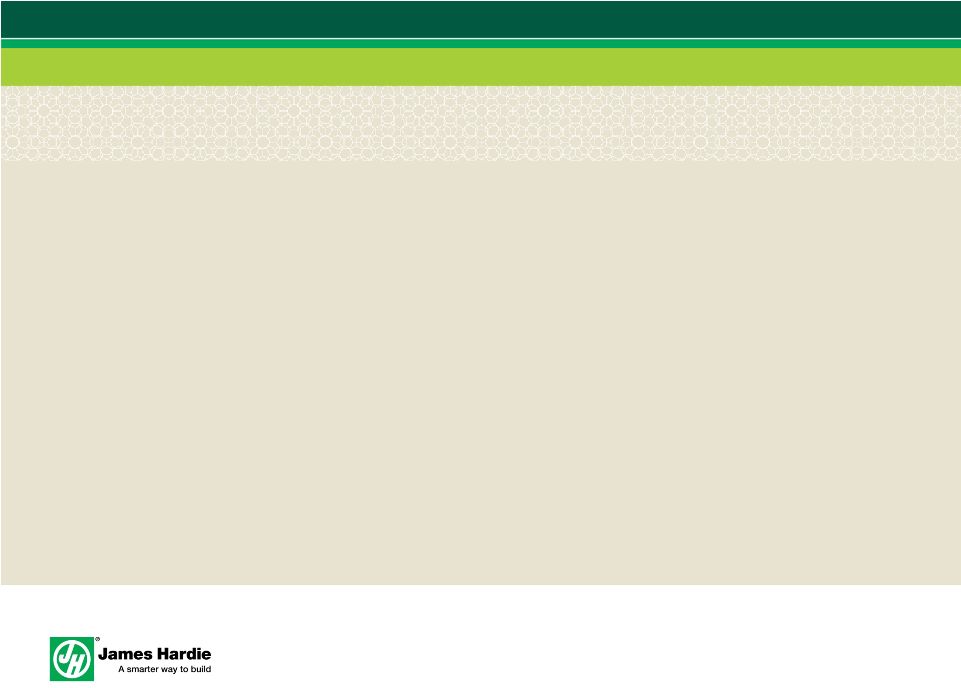 Disclaimer (continued):
Words such as “believe,”
“anticipate,”
“plan,”
“expect,”
“intend,”
“target,”
“estimate,”
“project,”
“predict,”
“forecast,”
“guideline,”
“aim,”
“will,”
“should,”
“likely,”
“continue,”
“may,”
“objective,”
“outlook”
and similar expressions are intended to identify forward-looking statements
but are not the exclusive means of identifying such statements. Readers are
cautioned not to place undue reliance on these forward-looking statements and all such forward-looking statements are qualified in their entirety by
reference to the following cautionary statements.
Forward-looking statements are based on the company’s current
expectations, estimates and assumptions and because forward-looking statements address future
results, events and conditions, they, by their very nature, involve inherent risks
and uncertainties, many of which are unforeseeable and beyond the company’s control.
Such known and unknown risks, uncertainties and other factors may cause actual
results, performance or other achievements to differ materially from the anticipated
results, performance or achievements expressed, projected or implied by these
forward-looking statements. These factors, some of which are discussed under “Risk
Factors”
in Section 3 of the Form 20-F filed with the Securities and Exchange Commission
on 26 June 2014, include, but are not limited to: all matters relating to or
arising out of the prior manufacture of products that contained asbestos by current
and former James Hardie subsidiaries; required contributions to AICF, any shortfall
in AICF and the effect of currency exchange rate movements on the amount recorded
in the company’s financial statements as an asbestos liability; governmental loan
facility to AICF; compliance with and changes in tax laws and treatments;
competition and product pricing in the markets in which the company operates; the
consequences of product failures or defects; exposure to environmental, asbestos,
putative consumer class action or other legal proceedings; general economic and
market conditions; the supply and cost of raw materials; possible increases in
competition and the potential that competitors could copy the company’s products;
reliance
on
a
small
number
of
customers;
a
customer’s
inability
to
pay;
compliance
with
and
changes
in
environmental
and
health
and
safety
laws;
risks
of
conducting
business internationally; compliance with and changes in laws and regulations; the
effect of the transfer of the company’s corporate domicile from The Netherlands to
Ireland, including changes in corporate governance and any potential tax benefits
related thereto; currency exchange risks; dependence on customer preference and
the concentration of the company’s customer base on large format retail
customers, distributors and dealers; dependence on residential and commercial construction
markets; the effect of adverse changes in climate or weather patterns; possible
inability to renew credit facilities on terms favourable to the company, or at all;
acquisition
or
sale
of
businesses
and
business
segments;
changes
in
the
company’s
key
management
personnel;
inherent
limitations
on
internal
controls;
use
of
accounting estimates; and all other risks identified in the company’s reports
filed with Australian, Irish and US securities agencies and exchanges (as appropriate). The
company cautions you that the foregoing list of factors is not exhaustive and that
other risks and uncertainties may cause actual results to differ materially from those
referenced in the company’s forward-looking statements.
Forward-looking statements speak only as of the date they are made and are statements of the company’s
current expectations concerning future results, events and conditions. The company
assumes no obligation to update any forward-looking statements or information
except as required by law. |
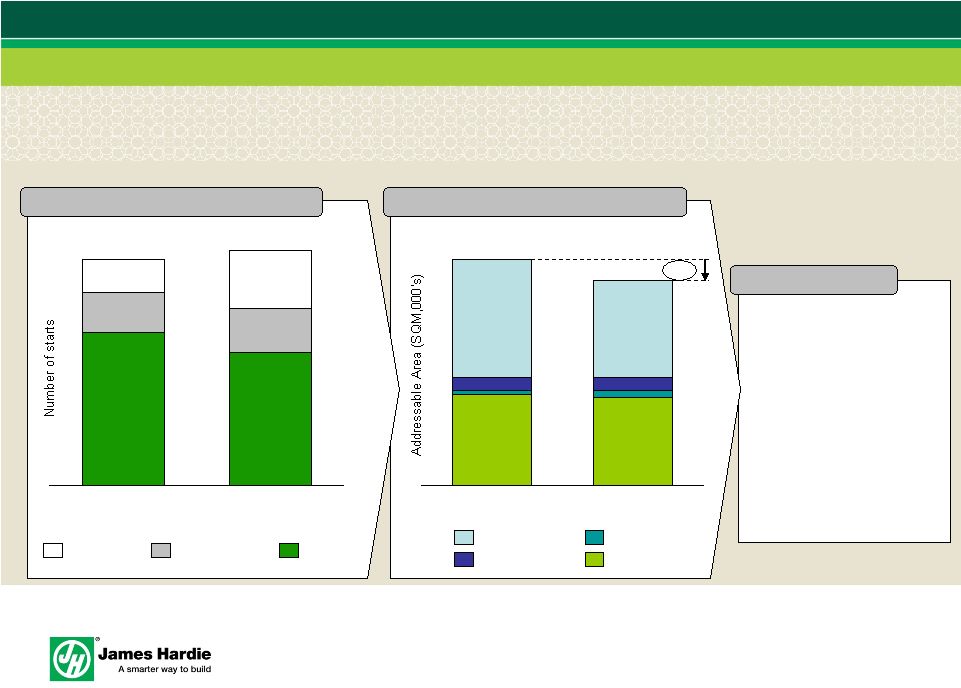 Market continues to shift towards density
119,000
102,929
30,240
34,315
25,670
44,665
2013/14f
181,909
2003/04
174,910
Detached
High density
Medium density
A change in construction starts…
Impacts addressable external wall area
Insights
•
Over the past 10 years,
detached housing starts have
decreased by ~ 15% whereas
medium and high density have
increased by ~ 40%
•
This trend towards higher
density building is impacting
the external addressable wall
area
-9%
A&A
Detached
Medium Density
High Density
•
The external addressable wall
area has decreased by ~9%
Source: ABS, HIA
Source: Abraham Akra –
JH Market Analyst |
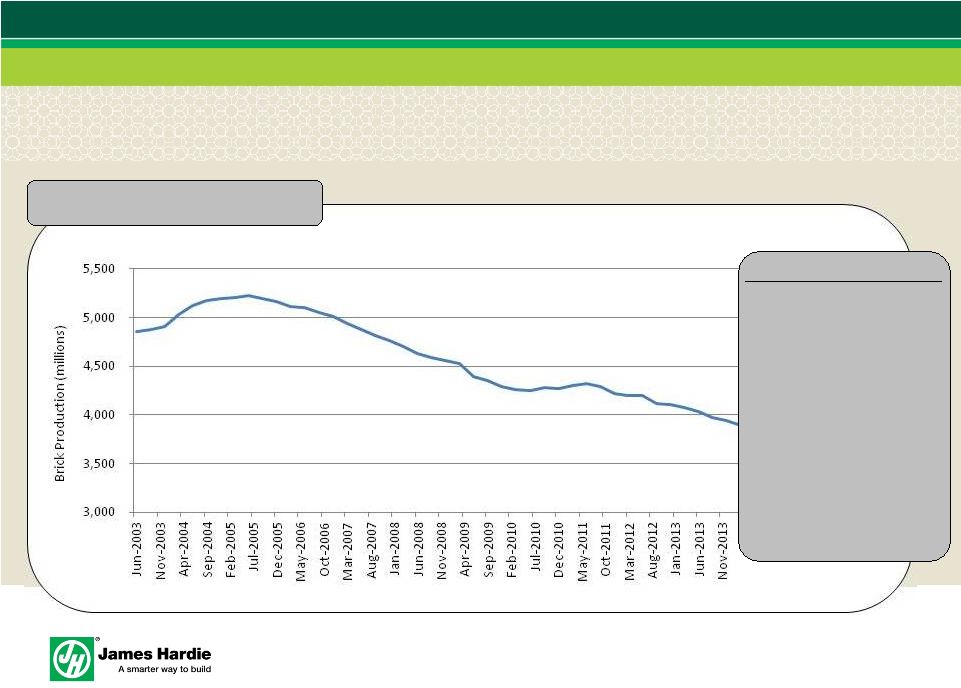 Decline of brick
Brick production: 10 year trend
•
Brick production is down
approximately 25% over
the past decade due to:
-
Shift away from
detached dwellings to
density
-
Converting builders
from double brick to
frame construction
-
Growth of monolithic
and other looks
Insights
Source: ABS |
 Several elements are impacting market dynamics
Market demographics
First time home buyers
Density shift
•
Population fragmenting
-
baby boomers
downsizing
-
Non traditional
families now the
norm, different
requirements
-
Land cost and
availability mean
developers looking
to maximize yield
•
Low interest rates
driving increased
investor activity –
local
and overseas
•
Credit still relatively
tight for low income
earners
•
Will increase to above
50% in the next few
years in large metro
centers
•
Shift away from single
detached housing to
medium & high density
•
Medium to high
density currently sitting
at 43% of all starts
•
Increase toward inner
city living
Competitive intensity increasing
i.e. More players, less to go
after…
•
First time home buyers
are at an all time low
•
Relative cost of house
and land increasing |
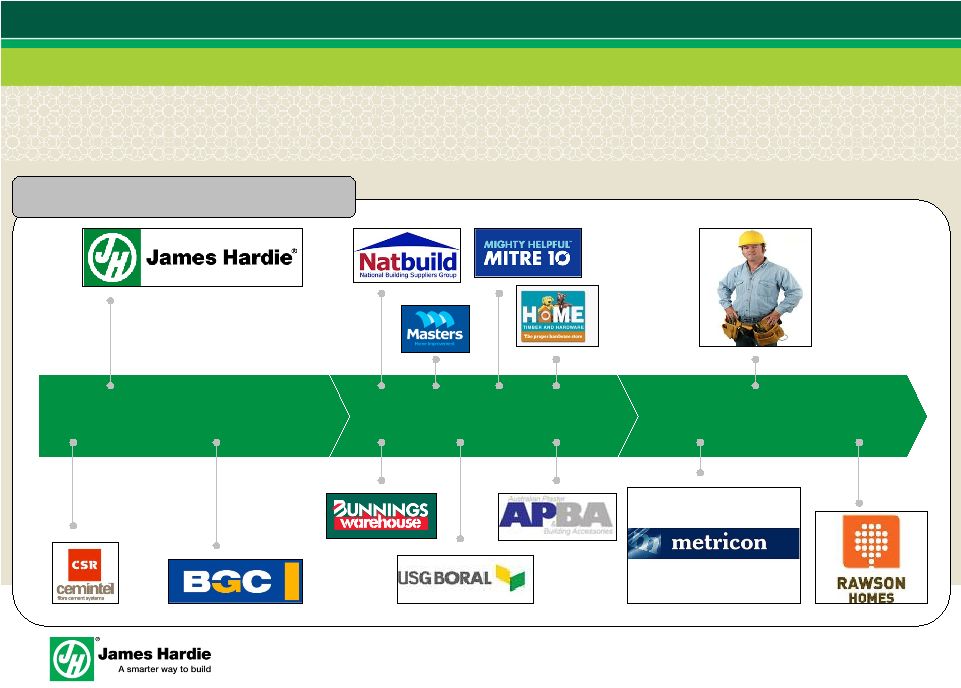 Key
elements of the Australian fibre cement market End user segments
Channel
Suppliers & major
players
Australian Fibre Cement Market |
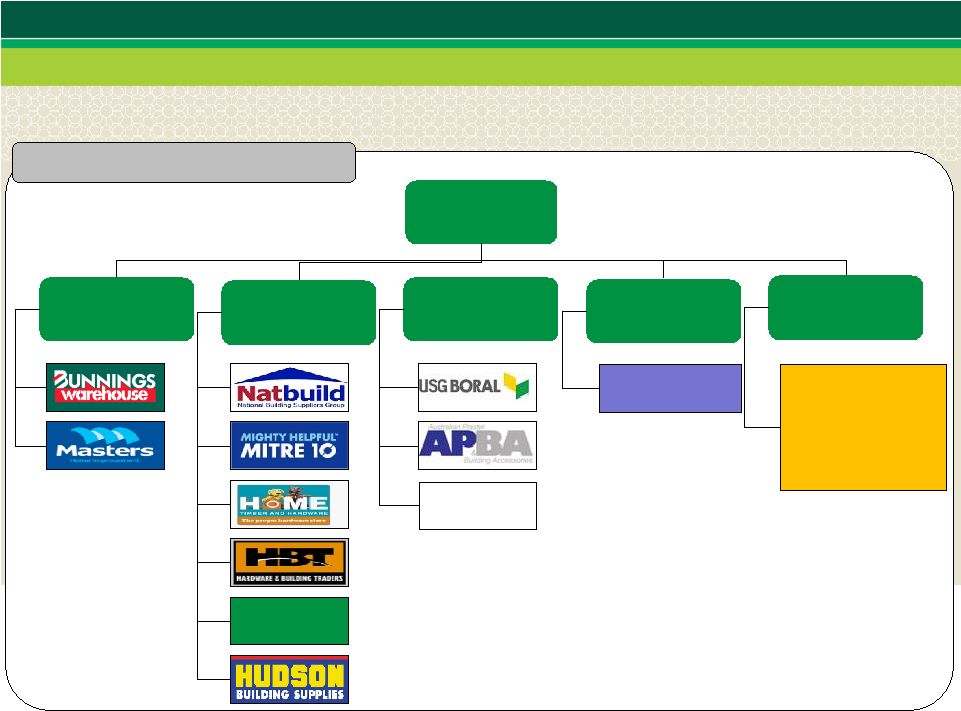 JH
Channel FY14
Australian Fibre Cement Market –
JH Channel
Building
Supplies
Independents
AILD
Internal linings
Commercial and
2 step players
Commercial &
2 Stepper
-
EXPORT
-
Frame & Truss
-
Plumbing
-
Manuf Housing
-
Walling Systems
-
Fencing Contract
Other
Big Box
Key players of the JH Channel |
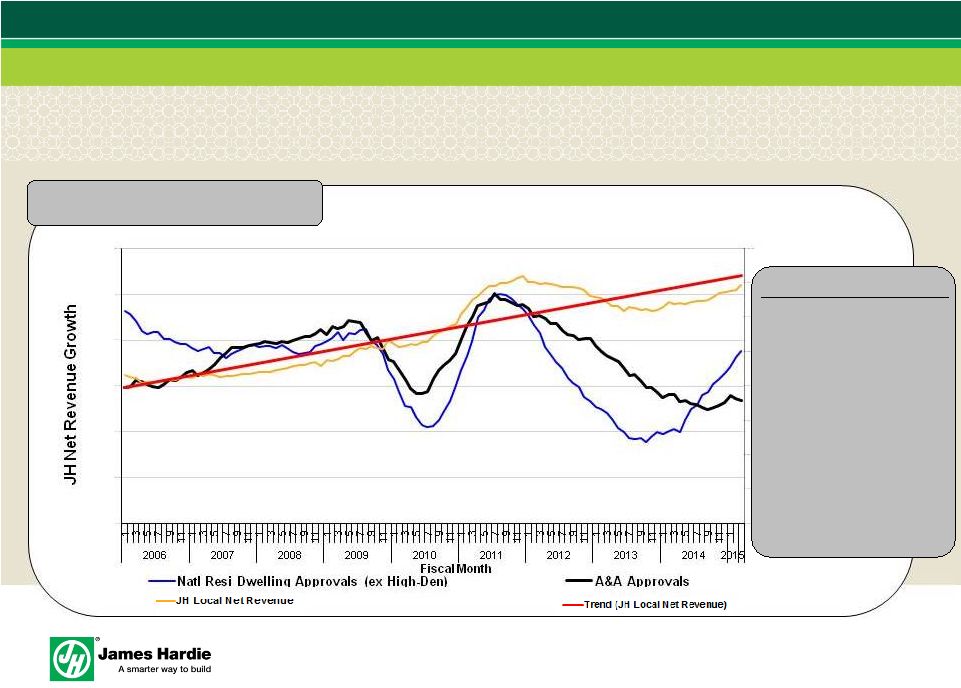 JH
Top Line Growth Top line growth
•
The upswing in new
construction has driven JH
sales in FY14 and FY15
Insights
•
House price improvements
along the east coast is
expected to lift A&A
activity and JH revenue in
FY16 and FY17
•
JH has enjoyed steady
revenue growth over the
last 8 years
Source: ABS |
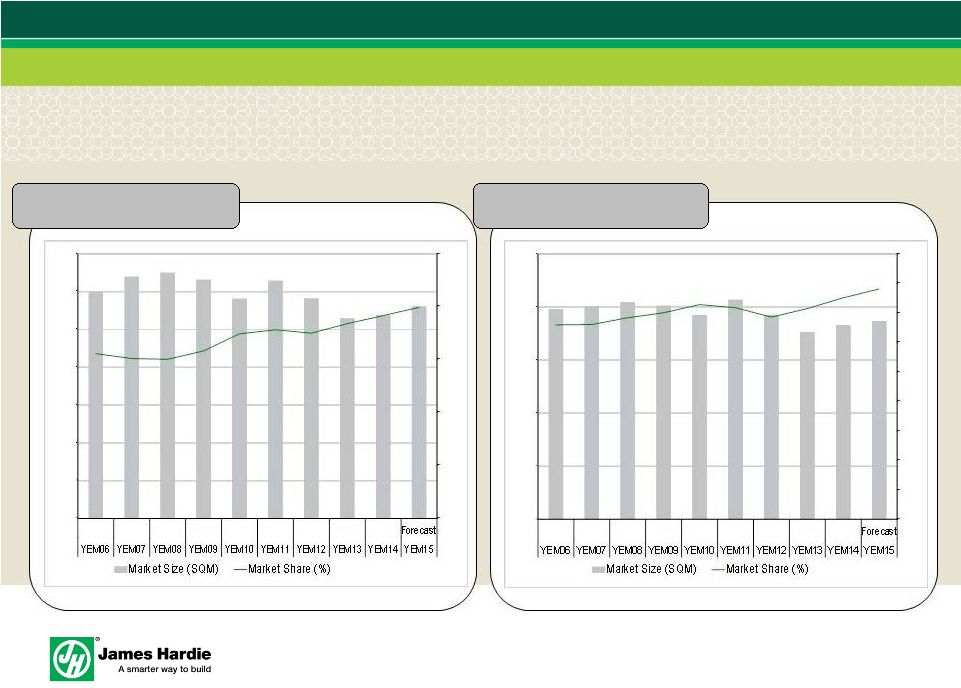 Addressable JH Market Share
External cladding
Wet Area Internal Linings
Source: Abraham Akra –
JH Market Analyst |
 Australian growth model
Australian growth model
•
Our model for growth is unique and sustainable,
but investment intensive
-
Large market opportunity
•
Our model differs greatly from other
manufacturers or importers
-
Superior value proposition
-
Proprietary and/or protected technology
-
Ongoing commitment to research and
development
-
Significant organisational advantages
-
Focused strategy and organisational effort
-
Scale |
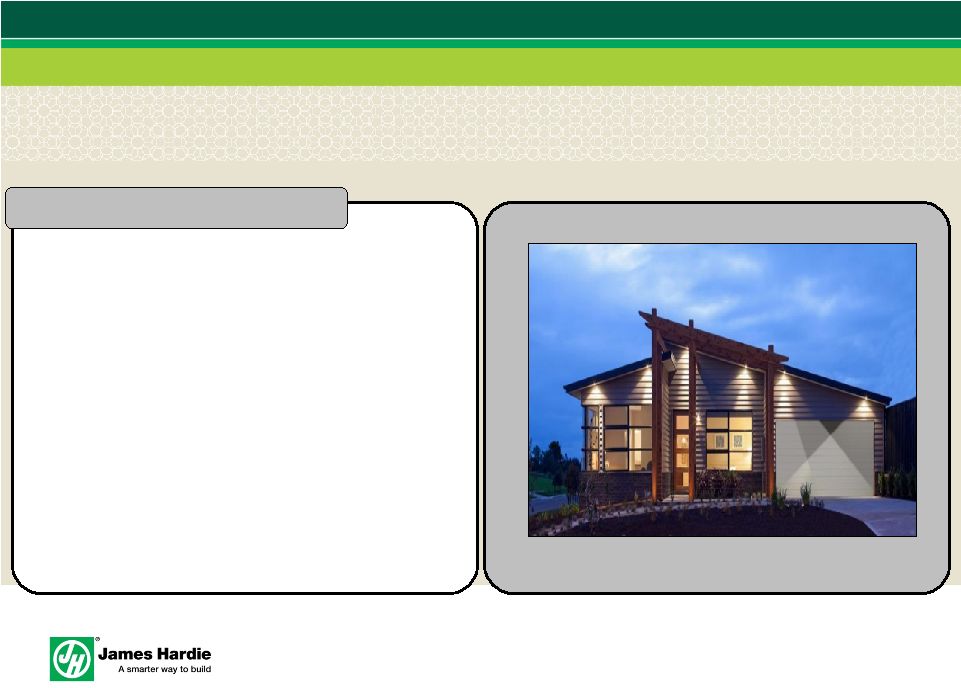 Australian primary demand model
•
Increase fibre cement penetration by creating
“Smarter Way to Build”
solutions
•
Accelerate uptake of lightweight / composite
construction
•
Engage with developers, designers, architects,
builders and industry associations
•
Leverage the unique JH Eco-System to
accelerate industry change in design and
construction and create new selling opportunities
for our aligned partners
Australian primary demand model |
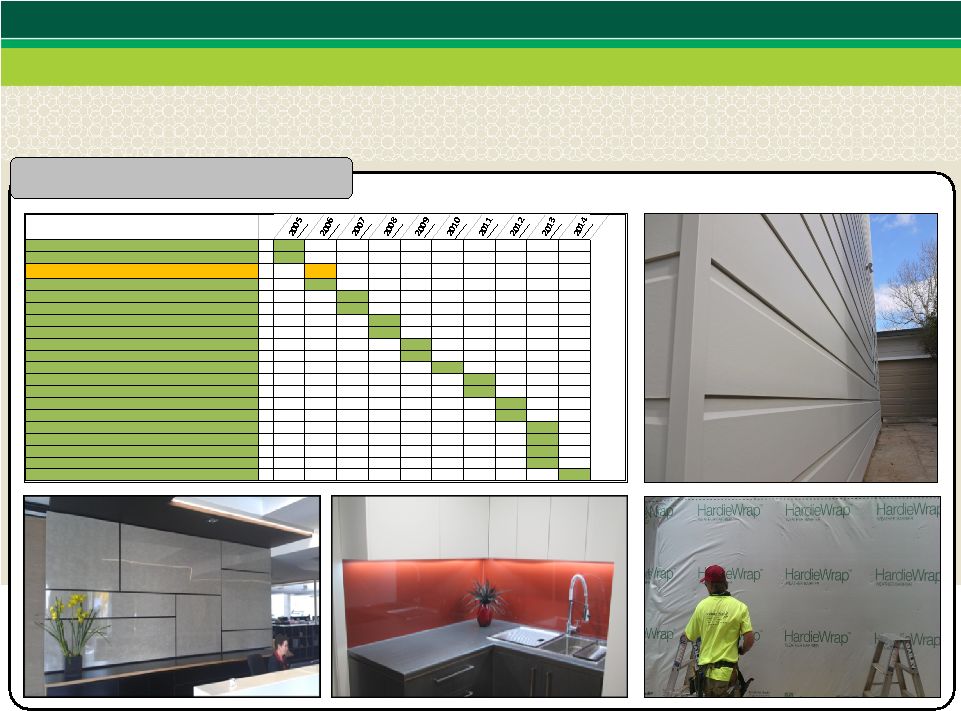 Driving Product Leadership
Aust Product Launch recent History
Linea
Aquatec
Scyon ™
Axon
Stria
Matrix
Axent Trim
Secura (Exterior)
Secura (Interior)
EasyLap
express PVC Joiners
Axon 400
Stria Wide
Hardiebreak
Al Z Flashing
ARChitectural Invibe & Inraw
Axon Grained
Stria Splayed
Secura 22mm & 18*9
Hardiewrap
InRaw
Splayed
HardieWrap
InVibe
Recent products launched |
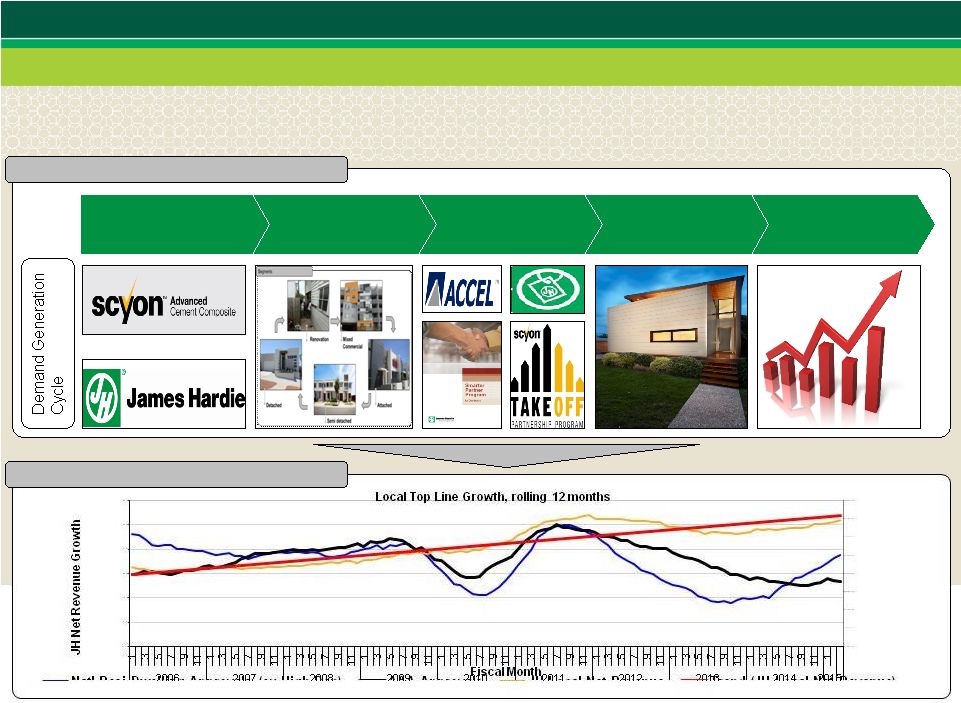 James Hardie go to market
Generating Demand
Sustainable
growth
Increased OTW¹
coverage
Growth focused
tools
Targeting the right
segments
Differentiated
products and
systems
1.
OTW –
On The Wall
The results |
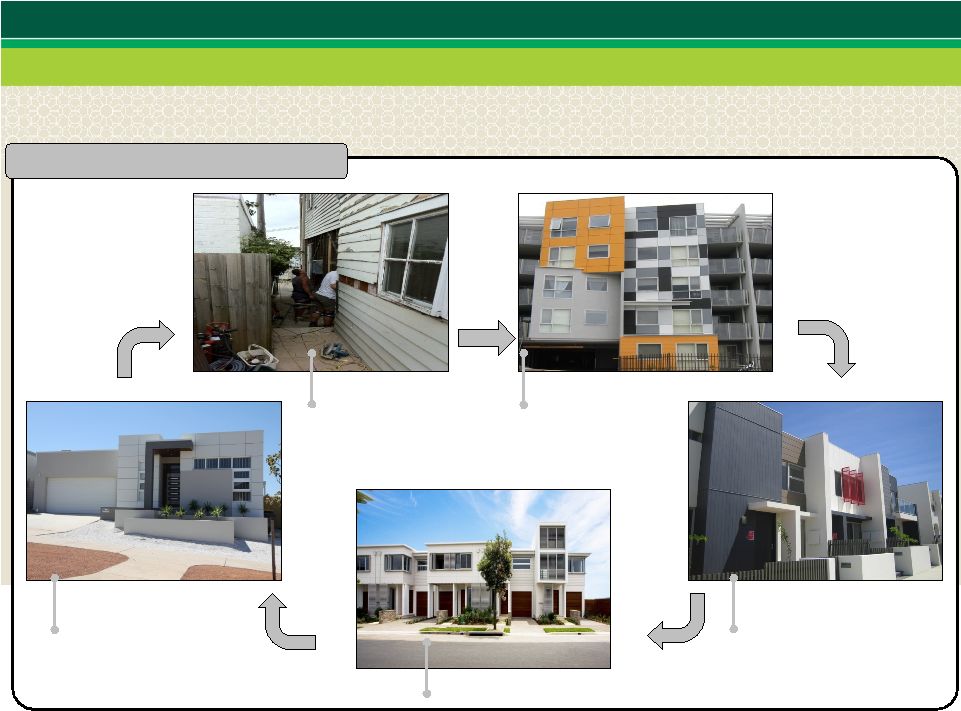 Renovation
Mixed
Commercial
Attached
Medium density
Detached
Targeted market segments
Segments |
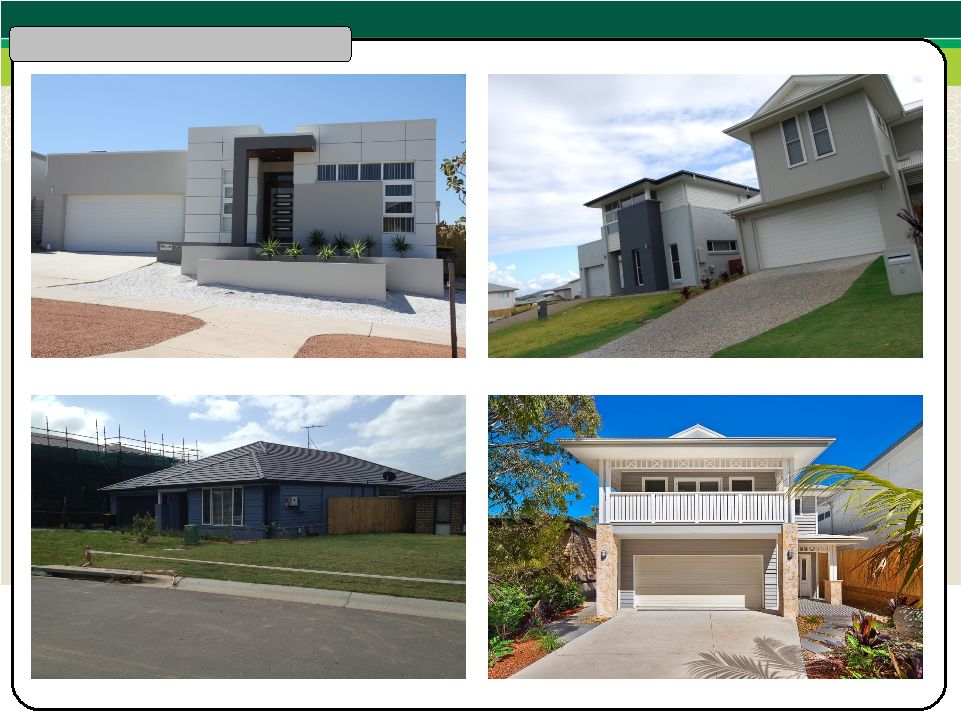 Detached homes |
 Compact detached and semi detached housing |
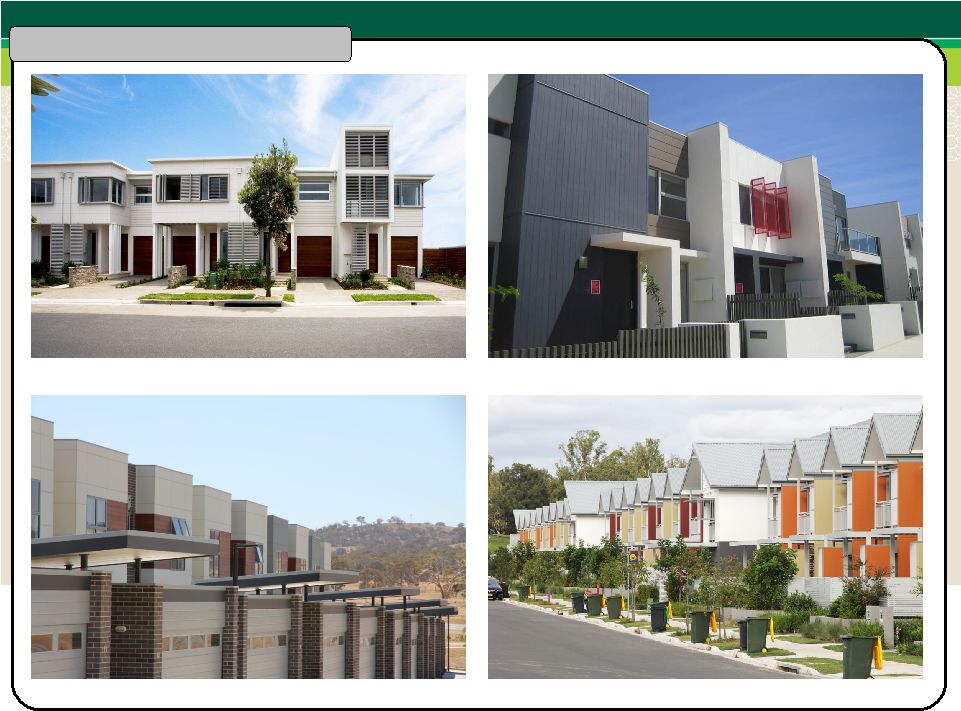 Medium density |
 Mixed commercial |
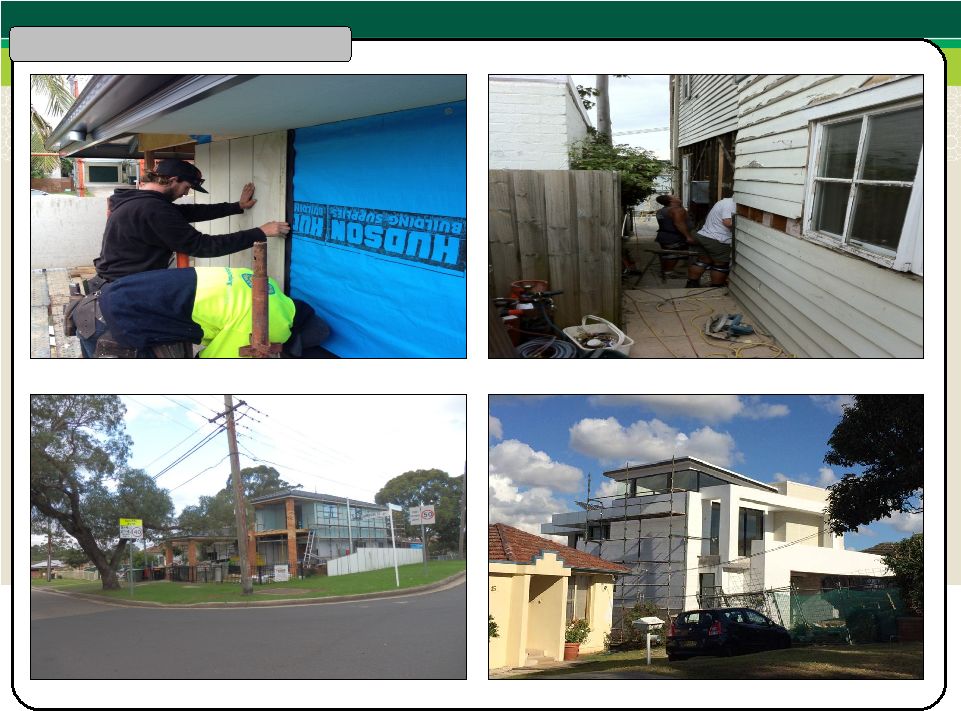 Renovation |